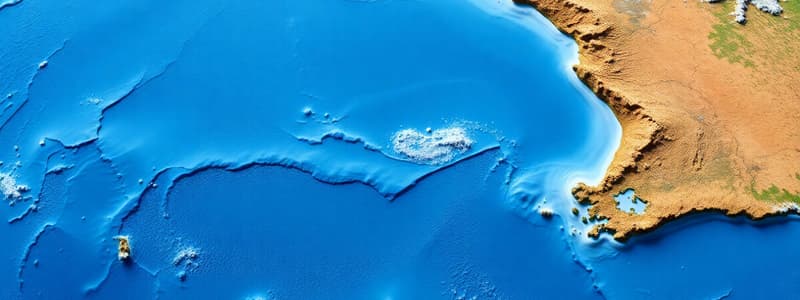Podcast
Questions and Answers
What is the primary composition of the Earth's core?
What is the primary composition of the Earth's core?
- Largely composed of lithosphere and asthenosphere.
- Predominantly solid rock and magma.
- Primarily basalt and granite.
- Mainly iron and nickel. (correct)
Which layer of the Earth constitutes the largest percentage of its volume?
Which layer of the Earth constitutes the largest percentage of its volume?
- The inner core.
- The outer core.
- The crust.
- The mantle. (correct)
What type of rock primarily makes up oceanic plates?
What type of rock primarily makes up oceanic plates?
- Limestone.
- Basalt. (correct)
- Granite.
- Sandstone.
The movement of tectonic plates is LEAST likely to directly cause which of the following?
The movement of tectonic plates is LEAST likely to directly cause which of the following?
Continental margins are best described as areas where:
Continental margins are best described as areas where:
Which geological process is primarily responsible for the formation of deep ocean trenches at active continental margins?
Which geological process is primarily responsible for the formation of deep ocean trenches at active continental margins?
What is a distinguishing feature of passive continental margins in terms of their continental shelves?
What is a distinguishing feature of passive continental margins in terms of their continental shelves?
How do sea canyons found at passive margins primarily differ in their formation from ocean trenches at active margins?
How do sea canyons found at passive margins primarily differ in their formation from ocean trenches at active margins?
The Andes Mountains, located along the west coast of South America, are a direct result of which type of continental margin?
The Andes Mountains, located along the west coast of South America, are a direct result of which type of continental margin?
What is the primary reason for the relatively uniform and flat inland geography associated with passive continental margins?
What is the primary reason for the relatively uniform and flat inland geography associated with passive continental margins?
Flashcards
Continental Margins
Continental Margins
The area where the Earth's continents meet the ocean floor, a boundary between different types of rocks.
Earth's Crust
Earth's Crust
The outermost layer of the Earth, made up of tectonic plates.
Tectonic Plates
Tectonic Plates
Large, rigid pieces of the Earth's lithosphere that move slowly over the surface, causing tectonic activity.
Active Continental Margins
Active Continental Margins
Signup and view all the flashcards
Passive Continental Margins
Passive Continental Margins
Signup and view all the flashcards
Subduction Zone
Subduction Zone
Signup and view all the flashcards
Oceanic Trench
Oceanic Trench
Signup and view all the flashcards
Continental Shelf
Continental Shelf
Signup and view all the flashcards
Study Notes
Continental Margins
- Continental margins are where continental rocks meet oceanic rocks at the edges of tectonic plates.
- Earth's layers include the core (inner and outer), mantle, and crust.
- The crust consists of the lithosphere (tectonic plates) and asthenosphere.
- Tectonic plates move slowly, causing earthquakes, volcanoes, mountain building, and ocean formation.
- Two types of plates exist:
- Oceanic plates: dense, young, composed of basalt.
- Continental plates: less dense, older, composed of granite.
- Plate movements (convergent, divergent, parallel) influence continental margin types.
Active Continental Margins
- Occur where continental and oceanic plates collide.
- Oceanic plates are denser, subducting beneath continental plates.
- Features of active margins:
- Varied inland geography: mountain ranges, sea cliffs, short rivers.
- Subduction zones: oceanic crust melts, creating magma.
- Narrow continental shelf.
- Ocean trenches.
- Volcanic and earthquake activity.
- Examples:
- Western coasts of North and South America (e.g. Andes Mountains, Cascades).
- East and Southeast Asia (e.g. Marianas Trench).
- Ring of Fire: high volcanic activity around the Pacific.
Passive Continental Margins
- Occur where continental and oceanic plates don't collide.
- Lack of significant tectonic activity.
- Features of passive margins:
- More uniform inland geography: flat plains, long rivers, estuaries.
- Wide continental shelf.
- Estuaries where rivers meet the ocean.
- Sea canyons: underwater erosion perpendicular to the coast.
- Examples:
- Eastern coast of North and South America.
- Africa, Antarctica, Australia (lack of seismic activity).
- Amazon, Congo, Nile, and Ganges Rivers.
Emergent and Submergent Coasts
- Emergent coasts: formed when the crust rises (active margins, rocky coastlines).
- Submergent coasts: formed when sea levels rise or crust sinks (wider river valleys).
- Both types relate to isostatic equilibrium (balance between the Earth’s lithosphere and asthenosphere).
Studying That Suits You
Use AI to generate personalized quizzes and flashcards to suit your learning preferences.




